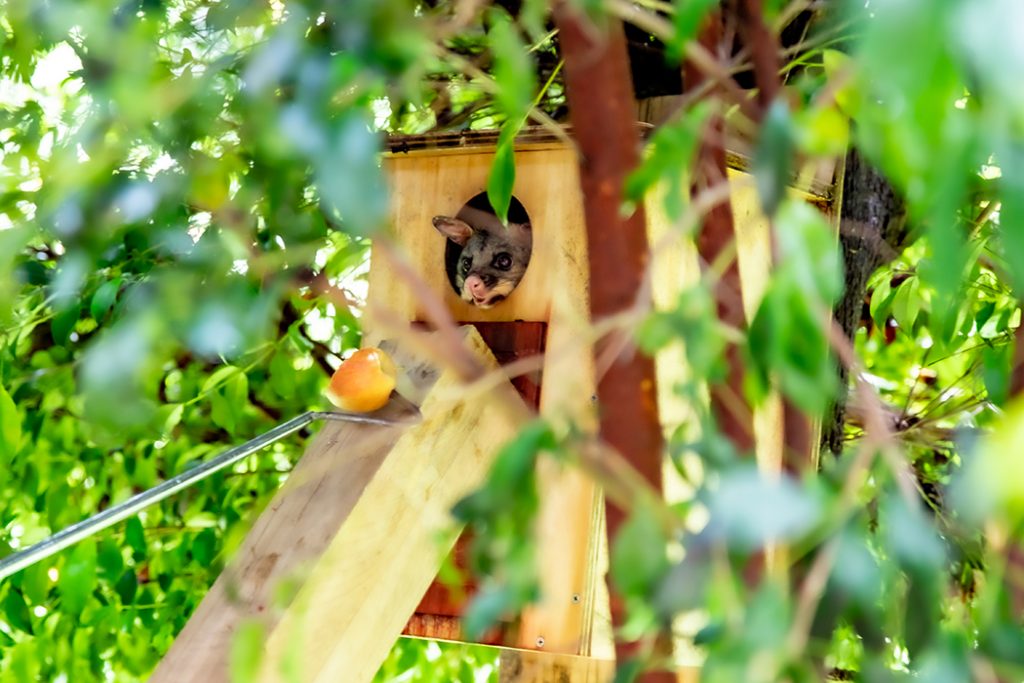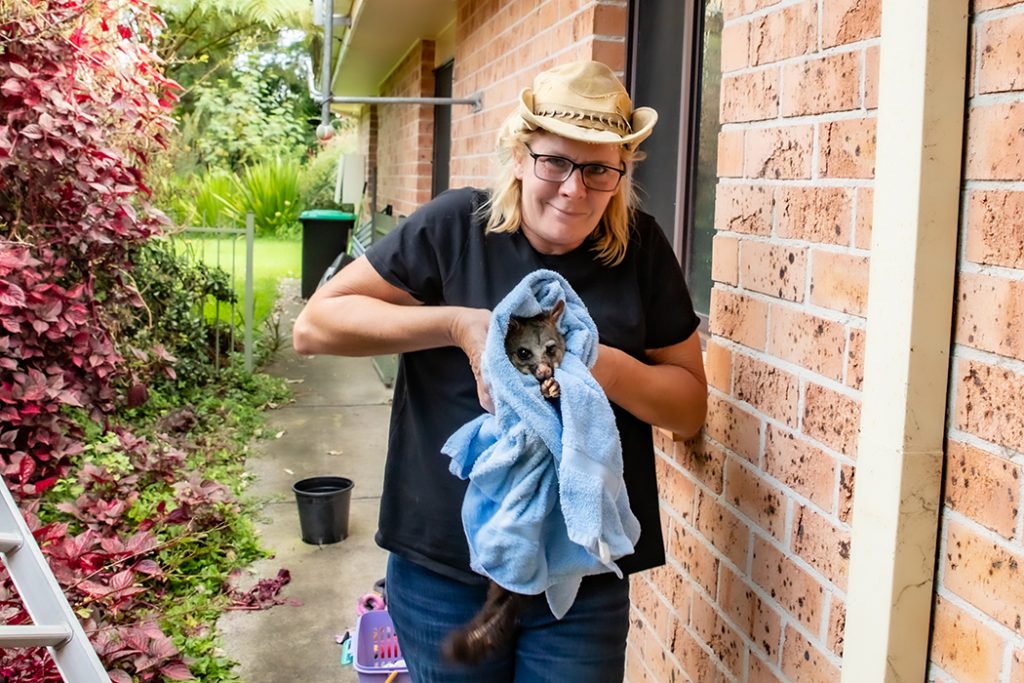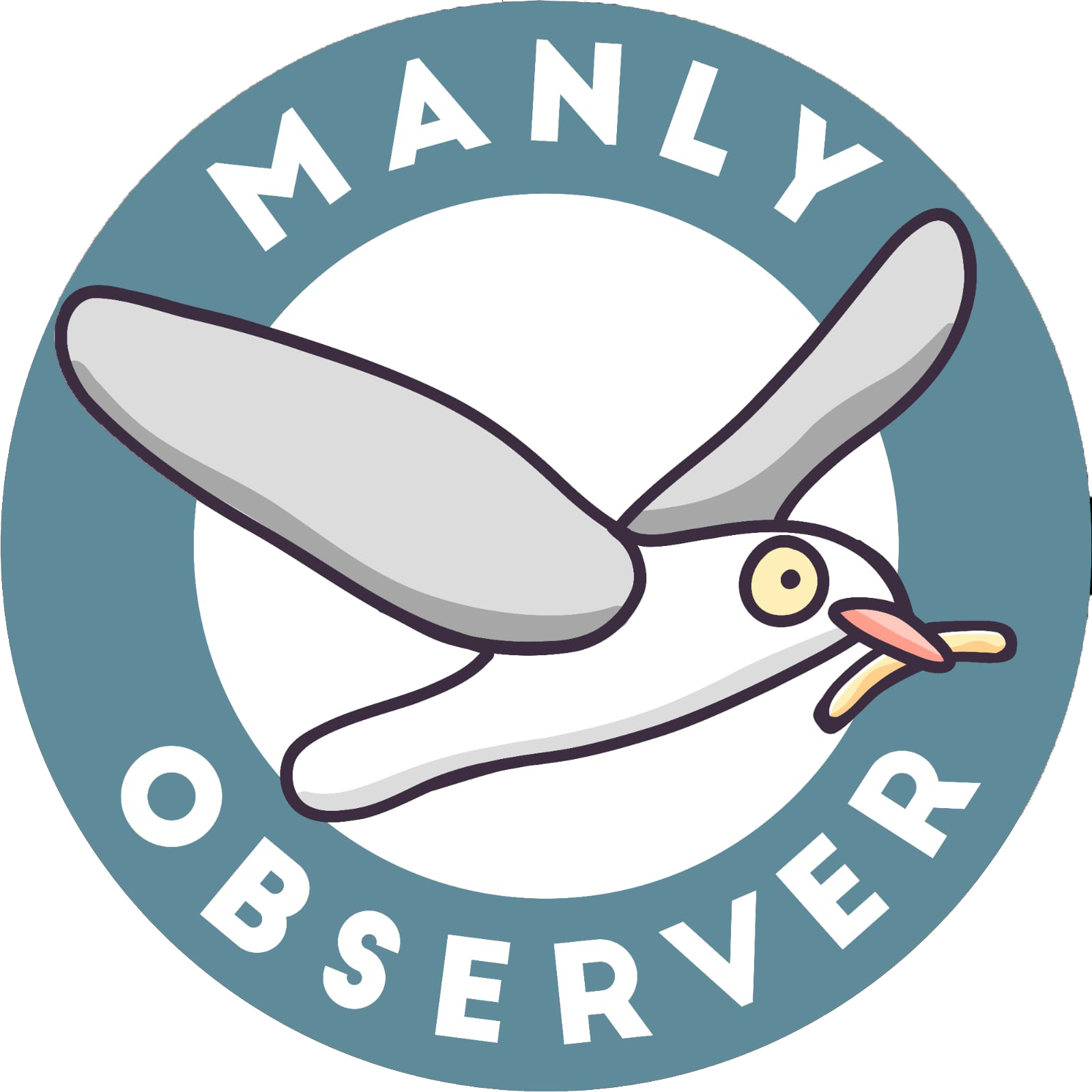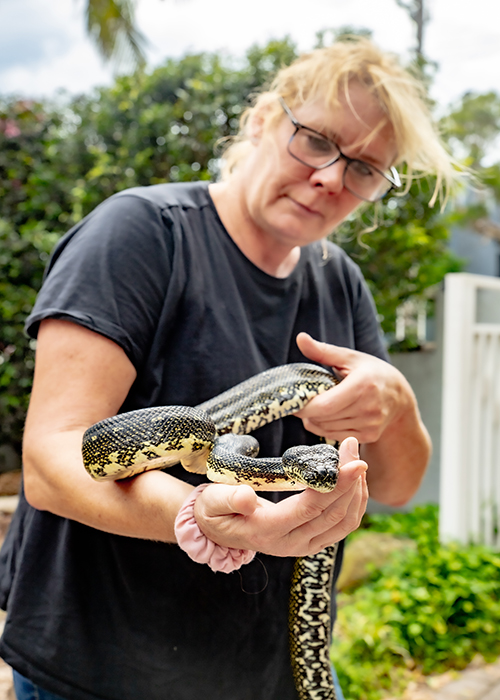It’s Saturday morning and most folks are taking kids to weekend sport or walking the dog. However, we’ve received a call to investigate a large snake curled up beside a swimming pool in a garden.
I’m with animal handler Georgie Campbell, 2021 Australia Day award winner, who has been a volunteer for Sydney Wildlife Rescue (SWR) for over 20 years.
Georgie, often accompanied by her teenage daughter Grace (also a highly experienced wildlife expert), covers the Northern Beaches and the suburbs around Frenchs Forest, dealing with sick, distressed, injured or displaced native animals and birds.
To say Georgie has a wealth of interesting experiences, is an understatement, if ‘wealth’ is the right word when you’re continuously tending to wildlife stricken by illness, mauled by cats, or hit by cars.
SWR volunteers have specialised skills to care for native wildlife, but some focus on particular animals or species. Georgie’s preference is serpents, and affixed to the rear of her vehicle is an amusing sticker bearing the edict: “I brake for snakes!”
Upon arrival at the suburban home with the unwanted intruder, Georgie, her daughter Grace, and me in tow, are directed by the homeowner to the rear garden. There a beautifully-patterned yellow and black snake with a bulging belly is curled up in the grass.
It’s a diamond python, which Georgie believes has recently dined on a brushtail possum.
However, it’s a cold and cloudy day with rain forecast and Georgie is concerned that the python appears reluctant to move on from its pool-side lounging.
“Normally, after a python has eaten, they find somewhere secluded to digest their meal, which can take four to five days,” she explains. “But I suspect this snake has been affected by the cold and that’s why it’s not moving. Out in the open it is vulnerable to attack from owls and other large predators, so it needs to be taken somewhere safe.”

Note: Native animals are protected in NSW by the Biodiversity Conservation Act 2016 (BC Act). Only licensed wildlife rescue and rehabilitation providers, or qualified vets, may take a sick, injured or orphaned native animal into care.
Regulations enforced by the NSW Department of Planning, Industry and Environment (DPIE) decree: “All licensed wildlife rehabilitators must comply with certain standards for the care of the native animals under their control to ensure animal welfare.”
Georgie opts to take the snake home to her terrarium, which has been furnished with all mod cons for selective serpents, including a heat lamp to warm up cold blood and a tree branch to wrap their coils around.
Pythons, as most people are aware, are non-venomous snakes that constrict their prey, but they will give a nasty bite if they feel threatened.
The next step is to persuade the diamond python to abandon the grassy poolside for the circumspect sanctuary of a cotton sack. Then it can be transported safely in Georgie’s car, without the risk of it slithering around and changing gears. Or braking for other snakes.
Georgie picks up the patterned python, which, after the initial surprise of being lifted by a strange creature, allows itself to be fed into the bag.
I was expecting furious flailing – if someone tried to push me into a sack I’d thrash about like a fish on a hook!
But this snake is stuffed full of possum, which explains its passivity, although Georgie reveals diamonds typically have a calm demeanour and are among the easiest snakes to handle.
Incidentally, do you know the difference between pythons and boa constrictors? Answer: all pythons are egg layers (oviparous), whereas boas give birth to live young.
After Georgie settles the snake in her home terrarium, we set off to Oxford Falls to release another python that was previously recuperating in the glass tank. The rehabilitated python will be liberated near to where it was first collected, because it is very important that native creatures are returned to their home territory.

Away from predators or teenage lads keen to expropriate an exotic pet, the reinvigorated snake is liberated in a dense thicket, where it blithely ascends a branch seeking its next meal.
Georgie admits there is a certain irony that an animal she rehabilitates and releases may then fall prey to another predator, perhaps one that she’s previously cared for – such as a possum becoming a meal for a snake.
But that’s Nature.
Part 2: pursuit of possums
Driving along Ralston Ave in Belrose we come upon a possum lying on the road surface. Tragically, this one was not ‘playing possum’ but had been run over and killed by a car.
After confirming it is lifeless, Georgie carries it to the grass verge, then spray-paints an orange X on the corpse. This is not a bizarre graffiti tagging ritual nor a coded warning against plague or witchcraft, but a notification to fellow wildlife monitors and council collectors that the cadaver has been logged and no babies are present.

A database of deceased wildlife is kept by DPIE that records where, when and (if possible) how native species are killed, and wildlife rehabilitation providers “must maintain a current register of all protected fauna reported, encountered or rescued” as part of their license conditions.
Georgie then responds to a call from someone who has been feeding a wild possum but now suspects it is sickly. We divert to a house in Belrose where a brushtail possum is residing in a nesting box attached to the trunk of a tree. The homeowner has constructed an elaborate aerial rope course nearby with apples attached at intervals for the possum to snack upon whilst tightrope walking.
Note: for native mammals like possums, apples are the equivalent of chocolate to humans: acceptable for an occasional sweet snack, but unsuitable as a meal substitute. (Although chocolate, specifically its active stimulant theobromine, is toxic to many animals, including possums, birds, horses and dogs.)
However, this brushtail possum remains box-bound, and although willingly accepting apple pieces presented at the entrance, is anything but bright-eyed and bushy-tailed.
The reluctant resident is lured out from the box with a piece of apple attached to a snake hook – a long pole with a curved end used by an experienced snake handler – and thereafter consigned to a carry-box.

Georgie can’t identify the possum’s problem, but decides to take it to a fellow SWR volunteer, Edwina Laginestra, an environmental scientist, toxicologist and highly experienced wildlife carer, who also specialises in possums.
Edwina’s garage is converted into a possum hospital, complete with specialist medication and care cages.
Edwina is also nursing several very young ringtail possums, whose respective parents were killed by different calamities, many of them caused by humans. One of these tiny babies is very weak and unlikely to survive.
Edwina can’t identify the marsupial’s malaise either. Her new tenant is transferred to a cage for rehabilitation, with a smorgasbord of foliage to graze upon, where it can be diagnosed and treated.
Next time we visit Edwina she has identified the problem: the possum has scorched feet, caused by electrocution. The incessant rains that have characterised the 2021-22 summer has resulted in a lot of arboreal mammals suffering electrical burns.
This is attributed to their habit of ambling across wet powerlines. Rainwater on the surface has increased the conductivity of the voltage within the cables, and, unfortunately, shocked a lot of high wire walkers.
Many of the casualties need to be euthanised, because the surge of electricity effectively cooks their internal organs, and they’ll suffer a slow and painful death if they’re ignored.

In the case of our apple-loving possum, Edwina’s diagnosis is optimistic. Ultimately it will be returned to the garden it calls home, with instructions to the householder to halt the apple diet. This will encourage the nocturnal forager to take advantage of the wide variety of edible foliage growing within close proximity to its nesting box.
Later, whilst driving, I receive a phone call from Georgie concerning a wallaby or young kangaroo that has been reported lying on the roadside near Lizard Rock in Belrose. She is across town, was I in the vicinity and able to inspect the body? As it happens I am close, so I make a detour.
A small furry form appears on the shoulder of the rural road. In torrential rain I inspect the lifeless creature – it’s a joey, possibly hit by a car. I take a couple of photos with my mobile phone and forward them to Georgie. She logs the incident, in case further reports on the unfortunate macropod are made to SWR.
That evening, when she has an opportunity to inspect the body, Georgie concludes that the joey likely became separated from its mother and succumbed to the cold and rain.
While the ‘Black Summer’ bushfires that dominated Australia’s 2019-20 summer burned more than 24 million hectares and killed an estimated three billion native animals, the ‘La Niña’ torrential rain that has characterised the 2021-22 Sydney summer has also contributed to a new surge in wildlife casualties.
These range from hypothermia and sickness, to birds and other tree dwellers flushed from nests, the drowning of animals in burrows or swept away in floods, and, thanks to the constant damp, a substantial increase in toxic mould.
Wildlife rescue and rehabilitation personnel have been kept extremely busy dealing with the effects.

Who are Sydney Wildlife Rescue?
Sydney Wildlife Rescue, licensed by NSW National Parks & Wildlife Service, was formed in May 1997 by experienced wildlife carers to “rescue, rehabilitate, and release sick, injured and orphaned native animals in the Sydney metropolitan area.”
SWR are active across the Sydney Metropolitan region, extending from the Hawkesbury River in the north to Picton in the south, and west from the Pacific Ocean to the base of the Blue Mountains.
The registered charity “strives to educate the community, at all levels, about the need to protect our native animals and to preserve their habitats.”
Operated entirely by volunteers, their rescue and advice service is available 24 hours a day, 7 days a week.
If you find an injured animal, call
02 9413 4300
Sydney Wildlife Rescue
https://www.sydneywildlife.org.au/
As well as a volunteer wildlife carer, Georgie, with her husband Grant, runs Addiction Food, a wholesale family business that manufactures environmentally-friendly gluten-free vegan sweets and treats.
Addiction Food
https://www.addictionfood.com.au




